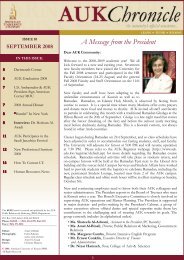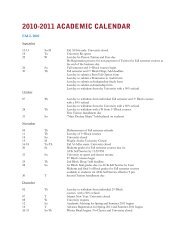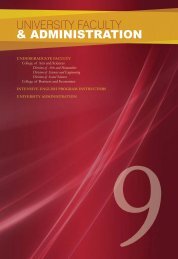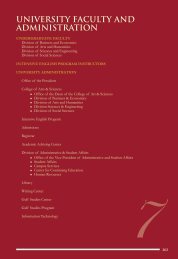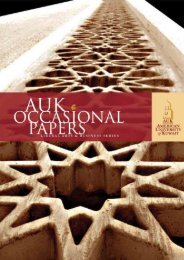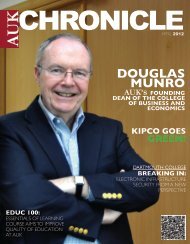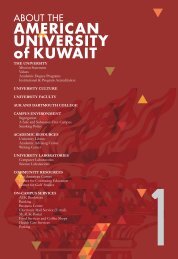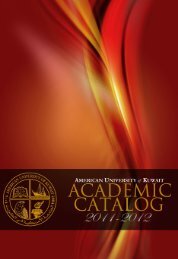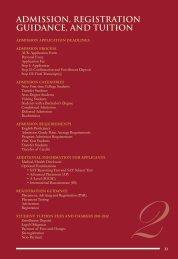etention. However, in addition, they found that enrollmentin consistently top-rated courses also significantly reducesthe probability of retention. In other words, the risingexpectations of the best and the brightest may, at times,only be met by exiting the university. These are the studentwe desperately want to keep! These are not drop-outs orstop-outs as discussed earlier—these are “top-outs.” Theyget bored, are not challenged, and leave.4. A Re-examination of the Role of First Year andDivisional Advising at <strong>AUK</strong>. In a recent survey of 1,000colleges and universities in the US, only 12% offeredincentives or rewards that recognized outstanding advisingof first-year students (Policy Center on the First Yearof College, 2003). Research shows that only minorconsideration is given to advising in faculty promotion andtenure decisions (Habley, 1988). In addition, over 2/3 ofpostsecondary institutions surveyed (1987) have no criteriafor selecting advisors (Crockett, Habley, and Cowart,1987). In fact, at <strong>AUK</strong>’s last faculty awards night, thosefaculty members recognized were recognized for theirpublications, not their teaching or service contributions.Based on his review of five national surveys of academicadvising, it became fairly clear, fairly quickly that, as Habley(2000) states, “…training, evaluation, and recognition andreward have been, and continue to be, the weakest links inacademic advising… These important institutional practicesin support of quality advising are at best unsystematic andat worst nonexistent” (p. 40). This presents an excellentopportunity for <strong>AUK</strong> to reexamine its current practices.5. <strong>AUK</strong> must recognize its inability to fully accomplishacademic and career preparedness in the context of anadvertised American model of Higher Education in asegregated learning environment. Mixed gender groupsand cooperative partnerships using face-to-face problembasedlearning methods to solve real world problems is nota reality in the gender segregated classroom, and createsinsurmountable pedagogical and international accreditationproblems, as recently evidenced. <strong>AUK</strong>’s administrativeposition thus far has been clear to faculty, staff, and students:We are guests in this country. If this issue is to be addressed,or changed, it must come from voters. That answer does notseem to be satisfying anyone. The owners of this universityare not guests of this country. Clear guidance, direction, anddeliberate and immediate courses of action are needed. Thisis a perceptual issue, and one less about local law, and moreabout institutional longevity. Less about holdings, and moreabout humanity. Less about short terms investments inproperties, and more about long term investments in people.In the interim, new <strong>AUK</strong> faculty should have theopportunity, during new faculty orientation, to be exposedto the latest teaching techniques appropriate to the gendersegregated classroom.6. The Establishment of a Teaching and Learning TechnologyCenter. <strong>AUK</strong> faculty are, due to intergenerationaldifferences and the rapid face of technology, generationsbehind current students in command of technology. Aninstructional technology development center is neededto enhance multimedia and computer-based learningapproaches, aid faculty in developing and utilizing thelatest technologies in curriculum development andcurricula, and foster greater integration of on line coursemanagement, to include platforms such as Web CT.7. Other. <strong>AUK</strong> student and faculty recommendationsvia self-report data for retention included: mandatoryfulfillment of prerequisites prior to course enrollment;mandatory advising prior to course registration; availabilityof 5-year course cycling plans via the web; a studentunion; adequate health, recreation, and sports facilities;a second-year experience; better, increased, and moreinnovative university advertising platforms; and increasedenforcement of university standards that promote studentresponsibility for their own actions.ConclusionIn a recent edition of Inside Higher Ed, the author describedthe new, for-profit university. He compared it to themovie industry, where a few companies make movies,and lots of others simply distribute them to theaters, ontelevision, and on DVDs. He described these universitiesas follows:“A small core of knowledge engineers who wrap coursesin to a degree to be distributed in cookie cutter institutionsand delivered by working professionals, not academics.There is no tenured faculty, no academic processes; thesole focus is on bottom line economic results. There21 st century institutions are not burdened with esotericpursuits of knowledge….they are market driven. [The] keysurvival mechanism is the ability to rapidly evolve to newenvironments and to position in the market. Since they donot carry tenured faculty, they can rapidly jettison disciplinesof study that do not penetrate market. Since they do nothave academic processes, they can rapidly bring to marketprograms that can capture market share….Not all havethe core capacities to compete long term in the market.Some emerge quickly, and as quickly become extinct.”17
18This is the thumbnail sketch of our primary marketcompetitors. Or, perhaps, this is the thumbnail sketch of<strong>AUK</strong>’s future. The present will determine our path, andit begins with retaining the best and brightest faculty andstudents.Memory and Subjectivityamong Kuwaiti Youths:Child Witnesses of the 1990Iraqi Invasion of KuwaitConerly Casey and Juliet DinkhaThe 1990 Iraqi invasion and seven-month occupationof Kuwait led to dramatic changes in the health andmental health of Kuwaitis, with 20% higher rates ofmortality and increased post-traumatic stress disorder(PTSD) among Kuwaitis who remained in Kuwait duringthe occupation (Public Health Impacts of Iraq’s1990Invasion and Occupation of Kuwait, Harvard School ofPublic Health, June 29, 2005). In the aftermath of theoccupation, numerous studies of children, based on thediagnostic criteria for PTSD—exposure to a traumaticevent and symptoms from each of three groups: intrusiverecollections of the trauma event, avoidance of remindersof the event and emotional numbing, and hyperarousal—established strong correlations between the Iraqi invasion,PTSD and depression, with higher prevalence rates forchildren than for adults (Abdel-Khalek 1997; Abdullatif1995; Al-Naser et al. 2000; Hadi and Llabre 1998; HSRPH2005; KISR 2005; Llabre and Hadi 1997; Nader et al. 1993).Yet, as Kirmayer, Lemelson and Barad (2007: 7) remindus, “What distinguishes PTSD from other psychiatricdisorders is the attribution of causality and the role thatmemory plays in its symptomatology”. The diagnosisof PTSD represents one strand in complex memoryprocesses that are biological and personal, but also social,cultural and political. The concept of trauma draws uponculturally variable idioms of distress, linked to social divideswithin Kuwait and access to resources, mental health andotherwise. Trauma, as a primary “wounding” may directour attention away from the amplification of past traumasby subsequent events and interactions (Hinton 2007: 447).Moreover, adults and children adopt certain feelings,ideas and ways of acting and remembering through directinteraction, and by indirectly “attending to how personsaround them are representing and constructing their worldthrough language” (Capps and Ochs 1995: 10). Adultsand children use cultural knowledge to make sense of andto narrate their own experiences of suffering. The effectsof trauma on our Kuwaiti child witnesses of the 1990Iraqi invasion reflect a convergence of veridical recall,socialization and enculturation practices of memory,emotion and subjectivity, and the transgenerationaltransmission of trauma through Kuwaiti parent-childinteractions, reconstructions based on family members’accounts of trauma.Using multiple methodologies—library research, mediacollections, participant-observations, semi-structured andperson-centered interviews, and family and communitystudies—our research focuses on four key questions:1) What are the relations of environmental contamination,PTSD and depression pre and post the 1990 Iraqi invasion?2) When does a memory become the memory, affectingsubjectivity, meaning and emotion?3) Is the U.S. War on Iraq triggering traumatic memories ofthe 1990 occupation? 4) How do memory and subjectivity,meaning and emotion, shape Kuwaiti familial and socialrelations? Our combination of approaches allows us togather social, cultural and political contexts and meaningsof young Kuwaitis' ideologies, attitudes, emotions, andactions in reference to the 1990 invasion and occupationand the current U.S. War on Iraq. Through narrationsof violence, the impact on socio- and psycho-culturalprocesses, we explore temporal and spatial convergencesof violence, fear and depression with other ongoingevents, ritual-religious calendars, the fetishization ofcertain forms of violence, and narrations of violence thathave wider social, political, or religious consequences thanthe acts of violence themselves.Child PTSD and DepressionShortly after the 1990 Iraqi invasion, Nader et al. (1993)found many children who remained in Kuwait during theoccupation to have multiple war-related exposures. Morethan 70 percent of the children in their study reportedmoderate to severe post-traumatic stress reactions.Witnessing death or injury and viewing explicit graphicimages of mutilation on television had a measurableinfluence on the severity of children’s trauma. Severalyears later, Al-Naser, al-Khulaifi, and Martino (2000)reported a prevalence of PTSD of 28.4% in sample ofKuwaiti citizens, with a higher prevalence of 45.6% in asubsample of students, whom the authors suggest haveincreased sensitivity to traumatic stress.
- Page 2 and 3: About AUK Occasional Papers:The AUK
- Page 4 and 5: higher education is distinguished b
- Page 6 and 7: The Impact of a Glass Ceilingon Wom
- Page 8 and 9: more women a chance to flourish in
- Page 10 and 11: consider other factors such as the
- Page 12 and 13: academically unprepared…you must
- Page 14 and 15: EmotionalSignificant variations in
- Page 16 and 17: Advising and OrientationOther impor
- Page 20 and 21: Hadi and Llabre (1998) assessed int
- Page 22 and 23: the event was encoded in parallel a
- Page 24 and 25: Public Health Impacts of Iraq’s 1
- Page 26 and 27: college work and have inadequate pr
- Page 28 and 29: memorization and repetition. This a
- Page 30 and 31: other in the pursuit of higher grad
- Page 32 and 33: for quality assurance, an organizat
- Page 34 and 35: RethinkingEntrepreneurship:Integrat
- Page 36 and 37: This type of training leads to enha
- Page 38 and 39: In short, Mount Allison students ha
- Page 40 and 41: Joplin, L. (1995). On defining expe
- Page 42 and 43: Figure 1. ExperientialEntrepreneurs
- Page 44 and 45: Kuwait - satellite television, cult
- Page 46 and 47: ReferencesAbt, V. & Seesholtz, M. (
- Page 48 and 49: interest in continuing to manipulat
- Page 50 and 51: Though corruption poses fundamental
- Page 52 and 53: A Cross-Cultural Modelof Innovation
- Page 54 and 55: were conceived as associations of c
- Page 56: others. In this case, confident pos
- Page 59 and 60: 58REFERENCESAmason, A. (1996) ‘Di
- Page 61 and 62: Shelton, C. and Darling, J. (2004)
- Page 63 and 64: 62• recycle natural resources use
- Page 65 and 66: 64Table Kuwait Fact Profile on Tran
- Page 67 and 68: Table Transportation and Associated
- Page 69 and 70:
68• Third, each mode of transport
- Page 71 and 72:
70• Prepare a Bank Group transpor
- Page 73 and 74:
7219. Stratford,A. (1974). Airports
- Page 75 and 76:
74may be developed in a safe and or
- Page 77 and 78:
28. Tables - 1 Environmental Manage
- Page 79 and 80:
6) EnvironmentalAwarenessNo baselin
- Page 81 and 82:
80Iran, the US, and HighlyEnriched
- Page 83 and 84:
82since the 1951 nationalization of
- Page 85 and 86:
8450% of the population is astonish
- Page 87 and 88:
86The US also approved the Shah’s
- Page 89 and 90:
88George W. Bush’s State of the U
- Page 91 and 92:
90when Iran could not keep up with
- Page 93 and 94:
92rich states, the decrease of natu
- Page 95 and 96:
94indigenous training. Specifically
- Page 97 and 98:
96It is important to note that Russ
- Page 99 and 100:
Table 1: Nuclear Powered States and
- Page 101 and 102:
100Foucault, Michel. “What are th
- Page 103 and 104:
102Ramazani, Rouhollah K. “Iran
- Page 105 and 106:
104My SCORE, OurMATCH: CommunityPar
- Page 107 and 108:
106with a mate while he does mechan
- Page 109 and 110:
108dimensions of life including for
- Page 111 and 112:
correlated to the commitment and on
- Page 113 and 114:
REFERENCESBryce, J, Frigo, T, McKen
- Page 115 and 116:
GDP $21,300, GDP growth rate 6.8%,
- Page 117 and 118:
• Less than half of the people su
- Page 119 and 120:
118TABLE 4: # 1 Gulf Country in Eco
- Page 121 and 122:
120• More men than women indicate
- Page 123 and 124:
TABLE 8: Why? X GenderGENDERMALE FE
- Page 125 and 126:
TABLE 11: Success in improving Livi
- Page 127 and 128:
TABLE 14: Success in preserving Cul
- Page 129 and 130:
• Gender wise, more men felt that
- Page 131 and 132:
TABLE 18: How foreign workers are t
- Page 133 and 134:
• In terms of the preference of e
- Page 135 and 136:
TABLE 24: Should Oil be the Basis f
- Page 137 and 138:
F i gur e 18: S hould K uwa it J oi
- Page 139 and 140:
13811. What do you think about the
- Page 141 and 142:
140Conditions of Kuwaiti Dependence
- Page 143 and 144:
1422) if the alien has no means of
- Page 145 and 146:
144offered Mubarak recognition as a
- Page 147 and 148:
146labor regulations and enforcemen
- Page 149 and 150:
148intensifying suspicion and hosti
- Page 151 and 152:
150Commission on Freedom of the Pre
- Page 153 and 154:
Even the viceroy of India, Lord Cur
- Page 155:
Christine PiconeAustralian College



